Process to produce polyols
a polyol and polymer technology, applied in the field of polyol production process, can solve the problems of low yield of desired products via the disclosed process, low yield of desired products, etc., and achieves the effect of reducing the number of polyols in the synthesis process, avoiding the use of long-chain polyols or high functionality
- Summary
- Abstract
- Description
- Claims
- Application Information
AI Technical Summary
Benefits of technology
Problems solved by technology
Method used
Image
Examples
example 1
[0038]Refined, bleached and deodorized (RBD) palm kernel olein (2700 g) was charged into 10 L reaction vessel and soya bean oil (SBO) (300 g) was charged into the same vessel. The ratio between RBD palm kernel olein and SBO in the oil mixture is 9 to 1 respectively. In another vessel, the required amount of hydrogen peroxide (50%, 731.34 g) and formic acid (94%, 197.89 g) for the epoxidation reaction was mixed and kept cool at temperature of 15° C. throughout the reaction. While the oil blend was stirred, the mixture of hydrogen peroxide and formic acid was slowly added into the oils blend (drop-wise). The epoxidation was conducted at temperature 40° C.-60° C. for about 2 to 3 hours. The epoxidation reaction was completed when the oxirane oxygen content (OOC) of the oil blend reached about 2.02%, which is about 89% of the theoretical OOC value. Then, the epoxidized oil were separated from the spent acids and washed with 4% NaCl solution (twice), followed by 1% sodium carbonate until...
example 2
[0039]The dried and neutralized epoxidized oils blend (2745 g) from example 1, with oxirane oxygen content of 2.02% and moisture content of 0.05% was charged into a 10 L reactor flask and then heated up to 60° C. The required amount of ethylene glycol needed for epoxy ring-opening reaction (alcoholysis) was about 193 g, based on the oxirane oxygen content of the epoxidized oils. The amount of ethylene glycol weighed was mixed with 12.15 ml of boron trifluoride (BF3) (48% in diethyl ether) to form a complex. When the temperature of the epoxidized oils mixture reached 60° C., the prepared complex of ethylene glycol and boron trifluoride was charged in portions into the same reactor. During the reaction, the oxirane oxygen content decreases from the initial value of 2.02% to about 0.01%, indicating the ring opening with ethylene glycol. The product was washed with 4% NaCl solution followed by 1% sodium carbonate solution until the pH of the aqueous solution about pH 8 to 9. Then it was...
example 3
[0047]The procedure in example 1 was repeated using the blend 80:20 in which 2400 g of RBD palm kernel olein was blended with 600 g of SBO in a 10 liters vessel. For the epoxidation reaction, the required amount of hydrogen peroxide (50%) was 940 g and formic acid (94%) was 254.4 g. The product was worked-up in the usual manner described in example 1. The yield of the epoxidized oil obtained was about 88%. The moisture content after drying: 0.04% and OOC: 2.6%.
PUM
| Property | Measurement | Unit |
|---|---|---|
| temperature | aaaaa | aaaaa |
| temperature | aaaaa | aaaaa |
| temperature | aaaaa | aaaaa |
Abstract
Description
Claims
Application Information
 Login to View More
Login to View More - R&D
- Intellectual Property
- Life Sciences
- Materials
- Tech Scout
- Unparalleled Data Quality
- Higher Quality Content
- 60% Fewer Hallucinations
Browse by: Latest US Patents, China's latest patents, Technical Efficacy Thesaurus, Application Domain, Technology Topic, Popular Technical Reports.
© 2025 PatSnap. All rights reserved.Legal|Privacy policy|Modern Slavery Act Transparency Statement|Sitemap|About US| Contact US: help@patsnap.com


